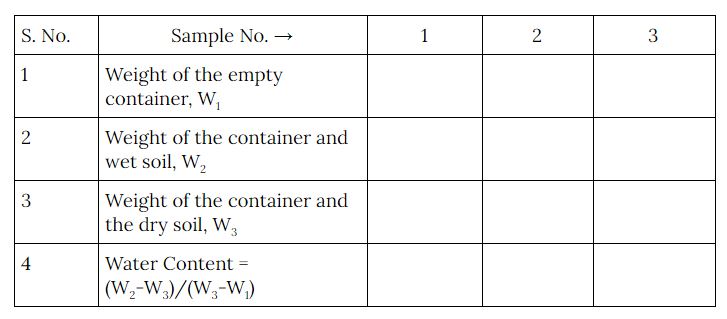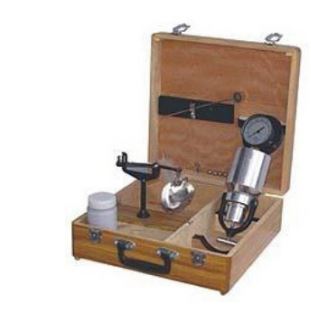The moisture content or water content of soil mass is a quantitative measure of a soil sample's wetness.
Water content for a particular soil mass is mathematically defined as the water's weight divided by the soil's weight.
Water Content, w = Weight of water / Weight of Soil
Importance of the Water Content of Soil
- The water content of soil can be used as an index attribute to identify the behavior and state of the soil.
- When we know the water content of the soil sample, we may determine some physical attributes of soil, such as bearing capacity, settling, and dry unit weight.
- Because the water content of soil samples changes during transportation and storage. The water content test should be the first test performed after the sample is received in the laboratory.
- Because the technique just includes weight measurements, the water content of soil may be calculated precisely. (Weights can be measured more precisely than volumes.)
Indian Standard Code dealing with the determination of the water content of the soil is IS 2720 (Part 2)

Methods to determine the Water Content of Soil
The water content of the soil sample can be determined by any of the following methods:
Oven Dry method
The oven-dry method is the most often used laboratory method for assessing soil water content. It is an extremely precise procedure...
Apparatus Required:
Desiccator, airtight container, electric oven, weighing machine
Note: A desiccator is a sealable container used to hold moisture-sensitive objects in order to keep their moisture content.t.
Procedure:
To determine the water content of the soil sample then, we need to follow the following steps-
- Clean and dry the container. Determine the empty container's weight (W1).
- Fill the container halfway with damp soil and weigh it (W2).
- For 24 hours, the soil sample is dried in an electric oven set to 105-110 degrees Celsius.
- Finally, using the container, record the steady weight of a perfectly dried soil sample (W3).
Observation and Calculations Table

Precautions:
- The temperature in the oven should not exceed 110 degrees Celsius because the water of crystallization may be lost above this temperature.
- Because dry soil absorbs water from moist soil, dried samples should be removed before placing wet samples in the oven.
Sand Bath method
The sand bath method is a field method for determining soil water content. It is a quick but inaccurate procedure.
Apparatus:
A sand bath, a tray, a weighing machine, a palette knife (Spatula), a furnace, or a spirit light
A sand bath is a huge, open vessel filled with sand.
Procedure:
- The empty tray should be cleaned and weighed (W1)
- Fill the tray halfway with the soil. The sample should be crumbled and placed in the tray loosely. Place some white paper on the sample.
- Weight the container containing the wet soil sample (W2)
- Position the tray in the sand bath. The sand bath is heated over a burner for 20-60 minutes to dry the sample. The drying process should be repeated until the sample reaches a constant mass.
- The sample is turned with the palette knife while it is heating. The soil sample should not be overheated. When the white paper overheats, it turns brown.
- The sample is removed from the sand bath after drying, cooled, and weighed (W3)
Calculations:

Pycnometer method
The Pycnometer method can only be utilized if the specific gravity of soil particles is known.
It is a quick way to test a soil sample with a specific weight. This approach is ideal for coarse-grained soil but not ideal for fine-grained soil. The pycnometer is a 900-mo bottle with a conical brass lid as a cover. A rubber washer is inserted within the conical cap to prevent water from leaking through the walls of the pycnometer and conical cap.
Apparatus Required:
Tamping rod, pyrometer, or vacuum tube
A pycnometer is a glass jar with a 1-liter capacity and a conical brass top with a small hole at the apex.
Procedure:
- The weight of a clean and empty pycnometer with a cap is recorded (W1)
- Determine the weight of 200-400 grams of moist soil sample in the pycnometer (W2).
- Fill the remaining volume of the pycnometer with distilled water or kerosene gradually.
- Remove the trapped air by heating and shaking the pycnometer or sucking it out with a vacuum.
- Weigh the pycnometer using earth, water, and kerosene (W3).
- After carefully cleaning the pycnometer, fill it with water/kerosene and weigh it (W4).

Calculations:
We use this formula to determine the water content-
w = [(W2 – W1)/(W3 -W4) × (G – 1)÷G) -1 ]
Torsion Balance Method
The Torsion Balance approach is particularly useful for soils that quickly re-absorb moisture from their surroundings after drying. Weighting and drying take place concurrently in this procedure. The torsion balance is adjusted to immediately provide water content.
Apparatus Required:
Infrared lamp, Torsional balance.
Procedure:
- Spread the soil sample uniformly in the sample pan of the infrared lamp.
- Start the infrared lamp and keep the temperature below 110°C.
- The water content of the drum can be read immediately from the scale.
- When the drum scale's pointer becomes steady, it signifies that the earth has dried (attained constant mass). This value represents the water content based on the dry weight (w').
Calculations:
Water content, w = w’ / (1 – w’)
Alcohol method
The methodology of determining the water content is similar to that of the oven-dry method, except that the drying process is finished by methylated spirit.
Apparatus Required:
An airtight container, knife, methylated spirit
Procedure:
- Take the weight of the empty and clean container (W1).
- Place the soil sample in the container loosely and weigh the container with earth (W2)
- Mix the damp soil with the methylated spirit (about 1 mg per gram of soil).
- Light the mixture. To achieve full drying, the mixture should be agitated with a knife.
- The container is then cooled with a desiccator once the methylated spirit has been entirely burnt away.
- Calculate the combined weight of the container and the dried soil (W3).
Calculations:

Calcium Carbide method
The calcium carbide method is based on the idea that acetylene gas (C2H2) is created when water in a soil sample combines with calcium carbide (CaC2). The water content of the soil sample can be determined indirectly by measuring the pressure of the generated acetylene gas. It's also called a Speedy or Rapid moisture test.

Apparatus:
Airtight containers, Calcium carbide, Dial gauge
Procedure:
- Place the powdered soil sample in the container and thoroughly mix it with the calcium carbide.
- The created acetylene gas exerts pressure on the diaphragm.
- The dial gauge is so accurate that it can immediately calculate the water content of soil based on its overall mass (wt).
Calculations:
The water content of the soil sample based on the dry mass is determined as:
w = w’ / (1 – w’)
Radiation Method
The radiation method is used to determine the water content of the soil in in-situ conditions.
Apparatus Required:
Steel Casings, Emitters, Detectors, and radioactive material (Cobalt 60)
Procedure:
- A radioactive isotope material (such as cobalt 60)-containing device is inserted in a capsule.
- It is then dropped into a borehole in a steel casing. Rays emerge via a small aperture on the side of the steel casing.
- A detector is installed inside a second steel casing with an entrance facing the first.
- Radioactive materials emit neuronal signals. The scattering of neutrons by hydrogen atoms causes energy loss in soil water.
- The amount of energy lost is related to the soil's water. The detector is calibrated to directly provide the water content.
Precautions:
The radiation method should be used carefully as it may cause a radiation problem. Therefore proper shielding should be ensured.
Report of the Water Content Test
The report of the water content test of the soil should contain:
- Soil sample specifics
- The test procedure was employed.
- Moisture/water content as a result. It should be reported to two decimal places.
- The drying temperature of the soil.
